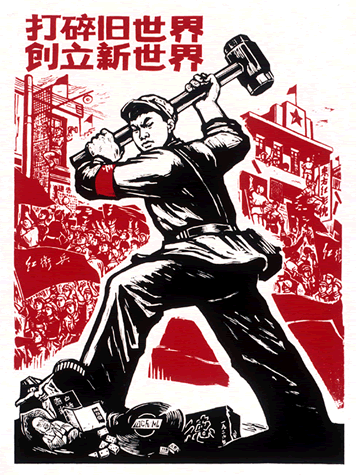20th Century: Communism & Internal Challenges
1911: THE FALL OF THE QING DYNASTY AND THE ANTI-TRADITIONALISM OF THE NEW INTELLECTUALS
Following the collapse of the Qing dynasty in 1911 the anti-traditionalism of the Chinese intellectual elite was embraced by the iconoclastic Chinese Nationalists and led to the widespread destruction of religious and ancestral temples in the 1920s. The New Culture Movement that followed the fall of the Qing dynasty focused on changing traditional structures and beliefs that were believed to be preventing China from dealing with the onslaught of the West on China’s soil. This very powerful internal assault on traditional beliefs characterized the first half of the 20th century in China.
When the Communists came to power in 1949, they combined the anti-traditionalism already developed among the Chinese intellectual elite with Marxist-inspired contempt for all religious beliefs. This anti-traditional/anti-religious stance of the early Communists was in a sense a “double blow” to traditional Chinese religious practices. The destruction of ancestral temples, village temples, city god temples and every other vestige of traditional practice was carried on with even greater enthusiasm and more thoroughness by the Communists after 1949, compared to what had been attempted by the Nationalists in the 1920s and early 1930s.
AFTER 1949: RELIGION UNDER THE COMMUNIST REGIME*
Since the establishment of the People’s Republic in 1949, freedom of religion, as well as freedom to propagate atheism, has been guaranteed in the Chinese Constitution. Yet the Communist party has consistently maintained a negative attitude; active suppression was greatest during the Cultural Revolution (1966-1976), and more recently has considerably abated.
Although diffuse (or popular) religion (see Notes, below) played a much larger role in daily life than did institutional forms, the government now only grants official recognition as religious groups to the major organized churches of Islam, the two major denominations of Christianity (Catholicism and Protestantism), Daoism, and Buddhism. All but the last two had been significant for only a minority of the population, and institutional Buddhism and Daoism had only a specialized and limited role in the religious life of most people.
Under the Communists, the number of believers affiliated at least publicly with the institutional religions had decreased significantly, but in the more permissive atmosphere of recent times, especially since the several national religious associations were reactivated in1979, Buddhism and both denominations of Christianity in particular have undergone a major revival, provoking renewed state suppression in recent years.
Pressure against popular religion, considered to be “feudal superstition,” had been greatest prior to the reforms begun in the late 1970s. Since popular beliefs constituted a religious framework for traditional social organization, they were viewed by the Communists as a major obstacle to the goal of radical reorganization. The Communist attack on popular religion thus was greatest during the periods of land reform (1950-1954) and collectivization (1954-1979), for popular religion reinforced traditional social alignments by emphasizing community solidarity and autonomy, values the Communists wished to replace with class consciousness and the integration of collectivized communities into a socialist economy and polity.
Thus, while popular religion as a whole was denounced and suppressed, community religion came under the strongest attack. Throughout China village temples, local Earth God shrines, ancestral halls and other such structures were dismantled or converted to nonreligious uses. Important elements of popular religion have survived, however, to varying degrees in different parts of the country.
During periods of greater repression, almost all such religious practices were carried out within the family, thus offering testimony to the continuing vitality and autonomy of family organization. Ancestor worship remains widespread, especially in the countryside, although even today it is sometimes practiced covertly: in some villages the objects of worship are tablets, scrolls or photographs kept at home; in others, tablets destroyed during the Cultural Revolution have not been replaced, but the rituals of ancestor worship are maintained. The joint worship by several families of a common ancestor is practiced far less frequently, for this involves organization above the family level. Within the family there continues the worship of other gods and spirits, at least in some parts of the country. It is not surprising that funerals appear to have consistently retained more of their religious content than other rituals. This presumably reflects concerns about mortality that cannot be satisfied by more contemporary world-views.
